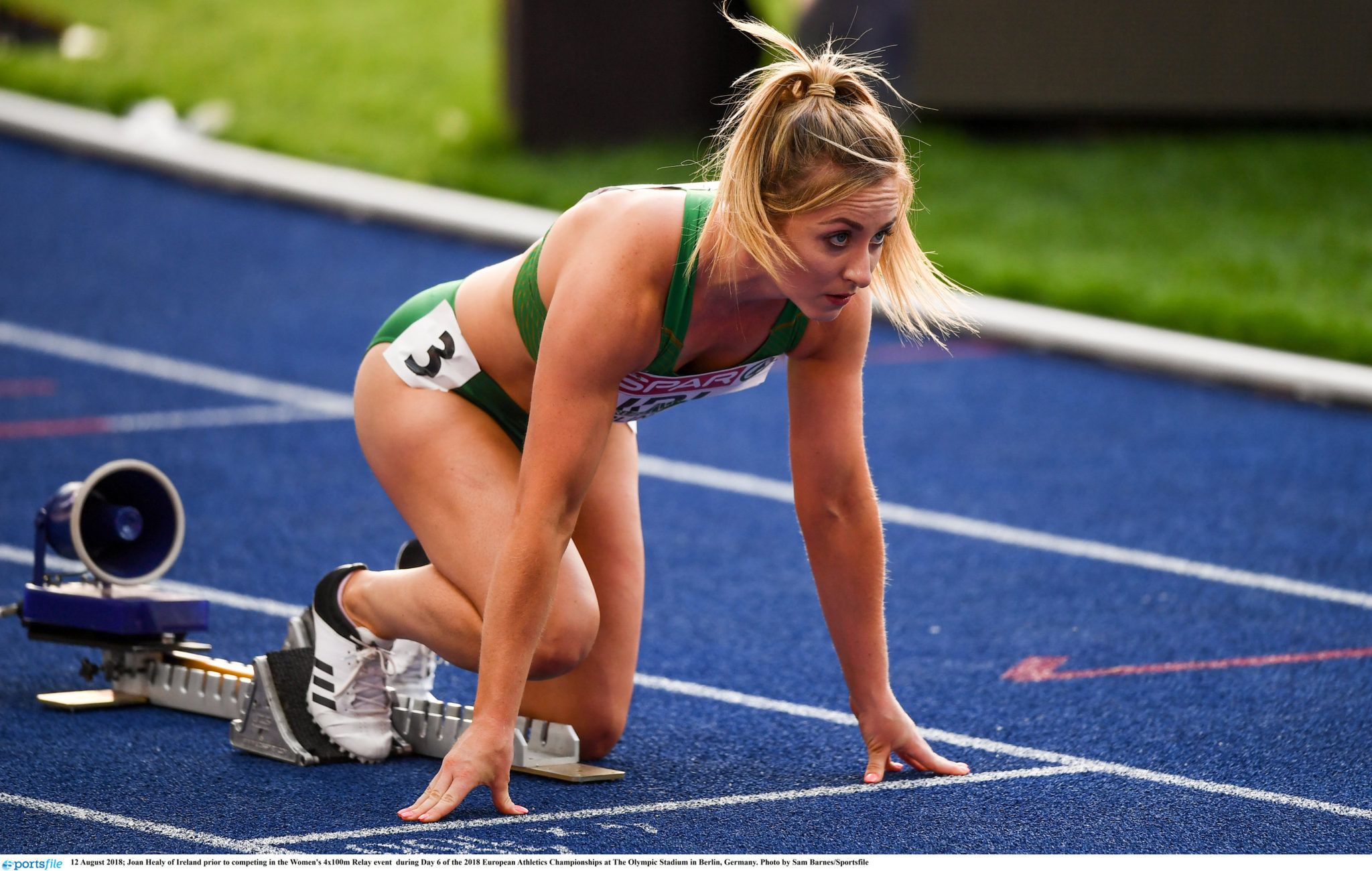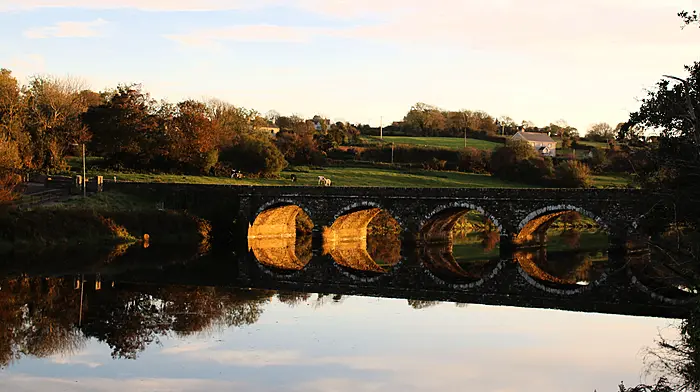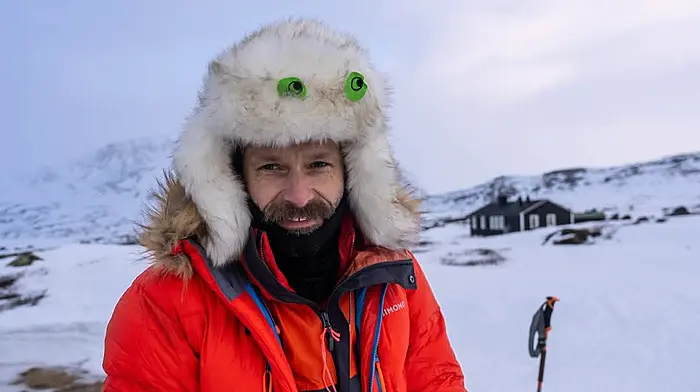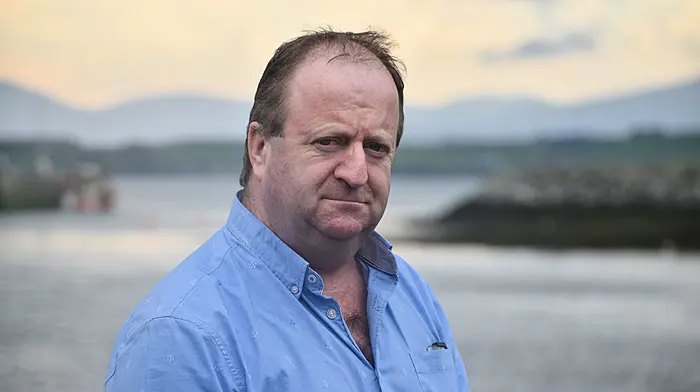JOAN Healy’s plans to bow out of athletics on her own terms later this summer have been ripped from her grasp.
Injuries have finally caught up with the Ballineen speedster and passed her out, leaving her no other option but to hang up her spikes earlier than she had hoped. Joan had pencilled this August in her calendar as the end date, but the irony isn’t lost on her that it’s another ‘awkward’ injury that has forced the 31-year-old sprinter off the track for good, bumping her from the fast lane to a slower pace.
Luck hasn’t been Joan’s friend for some time now, and injuries have been holding her back these past few years. The Achilles injury that dashed her Tokyo Olympic 4x100m relay hopes in 2021 really hurt. She hasn’t caught a break since. The weeks before her wedding last October, Joan was wearing a protective boot because of a fat pad issue in her left heel; that heel was strapped as she walked down the aisle towards her husband Fintan. Injury after injury. The latest one – a tiny tear in the plantar fascia in her jinxed left foot – delivered the knock-out blow in April.
‘I have dealt with a lot of injuries throughout my career. Luck has a big part to play in sport, but I have been incredibly unlucky with some injuries,’ she admits.
 Joan Healy has competed for Ireland at World and European levels for several years.
Joan Healy has competed for Ireland at World and European levels for several years.
‘They have been awkward and unusual things, not a calf tear or a hamstring tear; it’s always been tendons and nerves that have taken a long time to diagnose and are hard to heal,’ she adds – and the latest foot injury is a cocktail for disaster: niggling, painful, difficult to diagnose, interrupting the consistency of training and slow to heal. This was one injury too many for a sprinter who has competed on the World and European stages since 2008, especially with the finality of her planned retirement this summer looming. She had hoped to open her outdoor season on May 11th at the Belfast Irish Milers Meet, and then link up with the Irish women’s 4x100m relay team a few days later, so time wasn’t her friend either.
‘I had to make a decision,’ Joan explains.
‘I probably could get back running sometime in June, but the way things were going I couldn’t miss any more running sessions to be competitive. I wasn’t willing to put myself on the track, not prepared properly, and going to nationals and not being in the top two; I had no interest in that.’
Joan is ultra competitive so she wasn’t going to entertain the thought of turning up to the Irish senior championships at the end of June under-cooked. She still shudders at her performance at last year’s nationals – she finished fourth in the women’s 100m final in a time of 11.91, her second slowest time of her outdoor season. That still irks her.
‘It’s disappointing that my last race was that desperate performance at the nationals. That’s not how I wanted to end, but that’s how it is.’
***
Saturday, April 27th – that was the day Joan realised her athletics career was finished. The day before she received a nerve block from her consultant, Dr Joe Jordan, in the hope it would ease the pain that had surfaced again in her left foot the previous weekend.
‘I got up on Saturday morning, could still feel the pain, and I knew it was all over. I knew that was it,’ Joan says.
Sitting on the stairs at her home in Tower, just north of Cork city, she was struck by her own reaction.
‘It was very upsetting, but it was a massive relief as well,’ Joan explains.
‘It was a weight lifted off my shoulders. I don’t have to do it anymore. I don't have to wonder if I can do this session or that session – or will I be in pain while I am doing it.
‘I had pulled training back to the point where I was trying to get away with doing the bare minimum, so relief was the main feeling.’
 Joan Healy holds the Irish women's 4x100m record.
Joan Healy holds the Irish women's 4x100m record.
Perhaps deep down she was already reconciled to what was coming. The tears flowed during that week.
Things had started to snowball a few days earlier. The Sunday before, in the last rep at a training session in Limerick – with the Mardyke track out of action, Joan had to travel to train – she felt a pain in her foot. The next morning she couldn’t put any weight on it, so an MRI at the Bon Secours Hospital in the city was arranged for Wednesday. She had a feeling this was something that would wipe her out. There were tears that day.
‘Since April 2023 it was a back and forth – can I train, how much I can train. I was throwing everything I could at it to come back, but I kept being hit with niggles. When you have time constraints and then the track situation, it is stressful,’ she says.
The MRI came back clear, just like it had four weeks earlier when she had also felt pain in her left foot at the end of February; that was diagnosed as Tarsal tunnel syndrome, not a common injury. It was thought Joan’s latest setback was an irritation of the medial calcaneal nerve in her left foot, based on the area of her pain. That Friday she went in for a nerve block.
‘The anesthetic travelled further than it should have and it revealed a tiny cleft in my plantar fascia which suggested a tiny tear,’ she explains.
There were tears that day, too. Walking back to the car she felt it was all over, but she still held out hope the nerve block would work.
That Saturday morning when she woke up, Joan was still in pain. Game over.
***
Joan had started to put plans in place for life after running. This day was coming, but what stings is she didn’t have the opportunity to bow out the way that she wanted. She was denied a farewell summer – and the oldest of the Healy sisters from Ballineen deserved that, at least.
Before trailblazer Phil Healy, there was her older sister Joan who led the way. When she competed at the 2008 World Junior Championships in Poland, Phil was just 13 years old. Joan has been racing for over 20 years. Even though she works as a teacher at Terence MacSwiney Community College in Knocknaheeny, she knows too that she has been defined by her times on track; it’s been her identity.
‘When you meet someone they’ll say “you’re one of the runners”, so it’s trying to move away from that now,’ Joan explains.
‘For the last year I knew this day was coming. I didn’t expect it to come four months before I had decided to finish. I had been putting things in place. Athletes can struggle massively with their mental health when they stop because this takes over your life.
‘I wore an Irish vest at a young age and that competitiveness has always been in me; it took over. I have heard other athletes talk about how life is after competing so I consciously made an effort to put things in place and find things that I enjoy doing outside of training.’
Joan will return to full-time teaching in September, having reduced her working week to three days per week to concentrate on running. She will also start a masters in psychology course in Waterford in September. And also plans to roll up her sleeves and get involved in coaching, keen to pass on what she has learnt in a career that saw her race against the best at World and European levels. Her 7.30 60-metre personal best sees Joan sit tied in fourth in the all-time Irish list. Joan is part of the Irish 4x100m women’s relay team that holds the Irish record of 43.80; Phil was on that team, too.
There are so many great memories in there, too. At the World Athletics Championships in Oregon in 2022, Joan sat on a lane mark ahead of the women’s 4x100m relay heat and looked around the Hayward Field stadium, taking it all in and realising how far she had come from the injuries in 2021 that tore up her Olympic dreams. Moments like that will last.
‘The time has come. I will be 32 in September. Life moves on. There is another chapter we need to start, and I need to put the competing side behind me,’ she says, before the competitiveness surfaces again.
‘The only disappointing thing is I felt there were faster times in me,’ Joan says.
‘Injuries interrupted my consistency in training and I couldn't get the races together or ran out of time. That’s what disappoints me: the times beside my name. I think I definitely could have been faster over 60, there was faster in me. We can’t hang on those things, but we can hang on the good memories, the great races and the places we have travelled.’
 Joan Healy, right, beats her younger sister Phil to win the women's 100m at the 2016 Irish Universities Championships.
Joan Healy, right, beats her younger sister Phil to win the women's 100m at the 2016 Irish Universities Championships.
Watching Phil in action at the European Athletics Championships in Rome this week is difficult. A reminder of what could have been.
Joan’s forced retirement is still raw, and while she says Phil doesn’t believe her fully yet, she’s ready for the exciting adventures ahead.
Shifting down a gear or two now, she’s hard-wired to stay active. She’s still slotting in four sessions a week, between cardio and strength, but not at the same intensity.
For an athlete used to working at top speed, finding comfort in a slower pace is the challenge, but Joan has the plans in place to ease that transition. And being free from the pain of those constant injuries is a relief too. It’s time for the next chapter.








